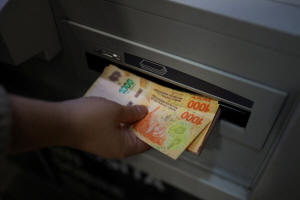Argentine bills strain wallets (literally) amid inflation drain
 Send a link to a friend
Send a link to a friend
 [May 24, 2022] By
Eliana Raszewski [May 24, 2022] By
Eliana Raszewski
BUENOS AIRES (Reuters) - Argentine peso
bills, devalued by years of inflation now soaring near 60%, are starting
to cause a literal strain on wallets - with the largest banknote in
circulation worth under $5 in commonly used exchange markets.
That means people need to carry around huge wads of cash, a security
concern and logistical headache for savers, businesses and banks.
The situation marks Argentina out in the region, except perhaps for
outlier Venezuela. The largest note in Mexico and Peru is worth around
$50, in Brazil it is $40, in Chile and Colombia some $25 and in Paraguay
$15.
In Argentina the 1,000 peso note is technically worth $8.40 using the
official exchange rate, but with strict capital controls limiting dollar
purchases most people use alternative markets where the same amount gets
you $4.80.
Ten years ago, 1,000 pesos was worth $200. Until around two decades ago
the same amount would have got you a full $1,000.
"I have to carry that huge wad of bills in my wallet, because it doesn't
fit in my pockets, and I fear getting robbed," said Laura, 40, a lawyer
from capital Buenos Aires.
"The 1,000-peso bill is no longer enough for anything. The (monthly)
rent for my house is just over 50,000 pesos."

Years of high inflation, tight capital controls since 2019 to prevent
currency flight, and popular black markets for trading dollars have hit
confidence in the peso.
The low value of the biggest tender means many businesses in the
cash-heavy economy are left with huge physical piles of money at the end
of the day. It is not unusual for people to arrive to pay larger outlays
with bricks of banknotes.
[to top of second column]
|

A woman withdraws cash from an atm, as Argentine peso bill continues
to devalue by years of inflation, meaning people need to carry huge
wads of cash, in Buenos Aires, Argentina May 23, 2022. Picture taken
May 23, 2022. REUTERS/Cristina Sille

"The denomination of the bills is very decoupled from
the average transactions of the economy," said Camilo Tiscornia,
director of C&T Asesores Economicos, adding that this creates
inefficiencies in the market. "You have to make ridiculous payments
with a huge number of bills."
A 1,000 peso note will hardly buy you two packages of top-end toilet
roll, while a children's menu hamburger with fries in a fast-food
chain comes in at 940 pesos.
While electronic payments have increased during the COVID-19
pandemic, a large part of sales are still made in cash.
President Alberto Fernandez, who is trying to lead a "war against
inflation," unveiled newly designed banknotes on Monday, but there
were no changes to the largest denomination. He contends that the
solution is finding a way to curb inflation, not issuing bigger
denomination bills.
A financial sector source said the situation was also straining bank
vaults, where physical cash simply takes up more room and creates
higher costs.
"For banks it is crazy time with operating and storage costs," the
source said, asking not to be identified. "Here we have entities
that are saturated with banknotes."
(Reporting by Eliana Raszewski; Editing by Nicolas Misculin, Adam
Jourdan and Rosalba O'Brien)
[© 2022 Thomson Reuters. All rights
reserved.]
This material may not be published,
broadcast, rewritten or redistributed.
Thompson Reuters is solely responsible for this content. |